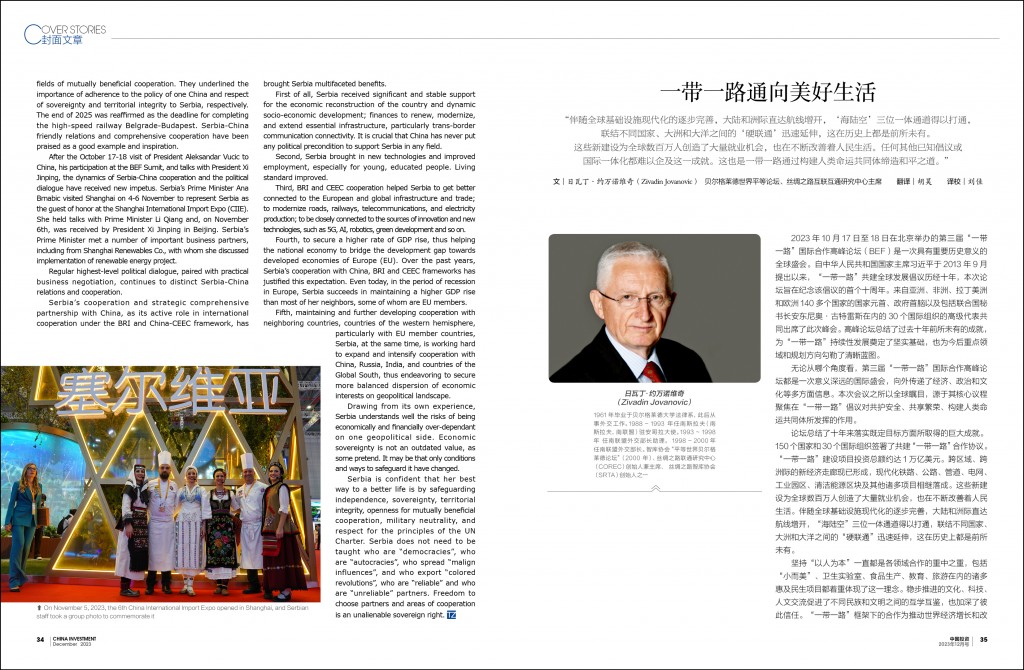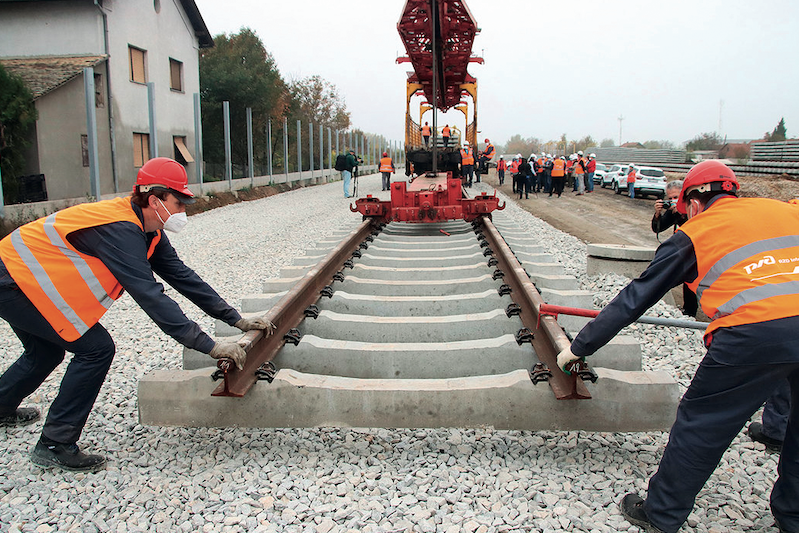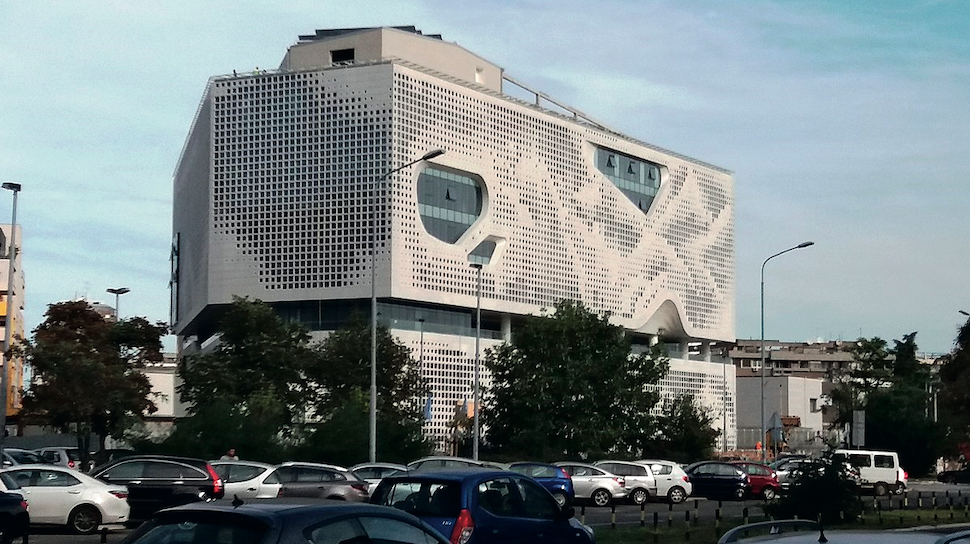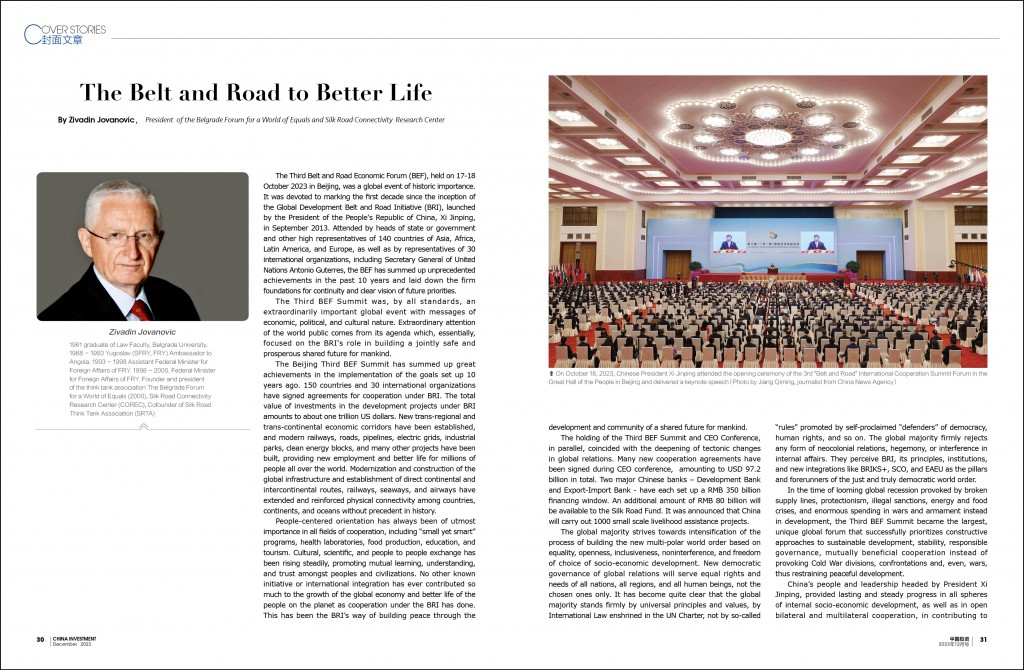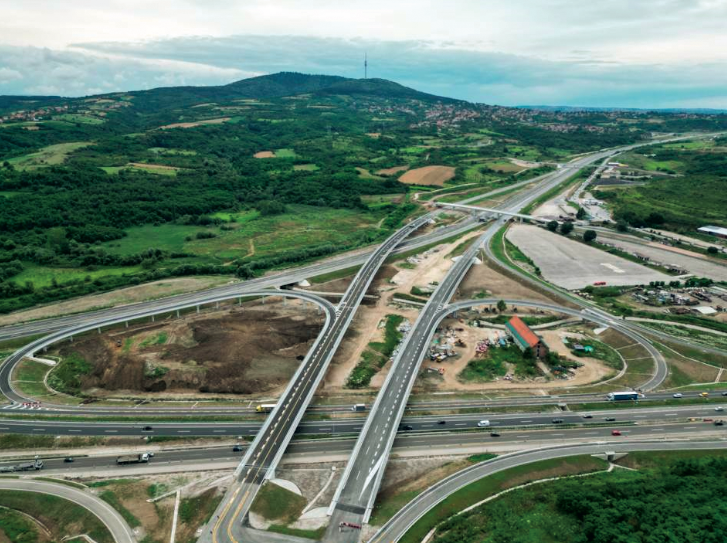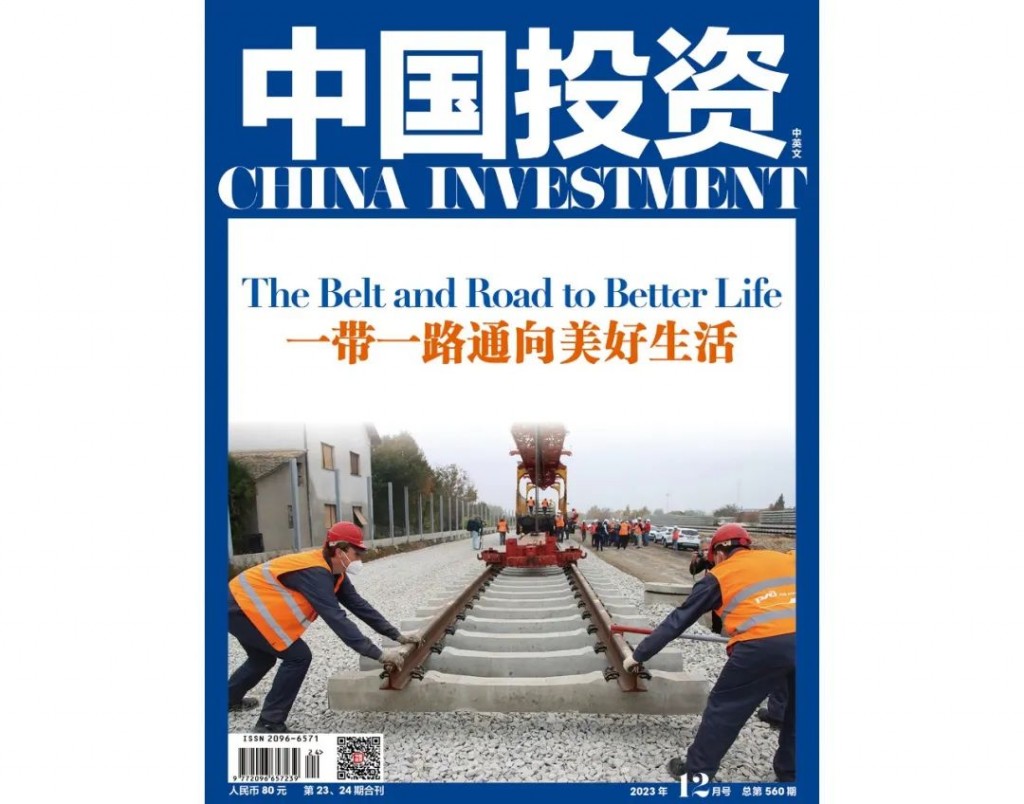
12月封面文章
一带一路通向美好生活
文|日瓦丁·约万诺维奇(Zivadin Jovanovic) 贝尔格莱德世界平等论坛、丝绸之路互联互通研究中心主席 翻译|胡昊 译校|刘佳
导读
●第二个十年重心
●塞尔维亚、中国与一带一路
●2016年的转折点
●成功标志
⬆ 玲珑兹雷尼亚公司
2023年10月17日至18日在北京举办的第三届“一带一路”国际合作高峰论坛(BEF)是一次具有重要历史意义的全球盛会。自中华人民共和国国家主席习近平于2013年9月提出以来,“一带一路”共建全球发展倡议历经十年,本次论坛旨在纪念该倡议的首个十周年。来自亚洲、非洲、拉丁美洲和欧洲140多个国家的国家元首、政府首脑以及包括联合国秘书长安东尼奥·古特雷斯在内的30个国际组织的高级代表共同出席了此次峰会。高峰论坛总结了过去十年前所未有的成就,为“一带一路”持续性发展奠定了坚实基础,也为今后重点领域和规划方向勾勒了清晰蓝图。
无论从哪个角度看,第三届“一带一路”国际合作高峰论坛都是一次意义深远的国际盛会,向外传递了经济、政治和文化等多方面信息。本次会议之所以全球瞩目,源于其核心议程聚焦在“一带一路”倡议对共护安全、共享繁荣、构建人类命运共同体所发挥的作用。
论坛总结了十年来落实既定目标方面所取得的巨大成就。150个国家和30个国际组织签署了共建“一带一路”合作协议。“一带一路”建设项目投资总额约达1万亿美元。跨区域、跨洲际的新经济走廊现已形成,现代化铁路、公路、管道、电网、工业园区、清洁能源区块及其他诸多项目相继落成。这些新建设为全球数百万人创造了大量就业机会,也在不断改善着人民生活。伴随全球基础设施现代化的逐步完善,大陆和洲际直达航线增开,“海陆空”三位一体通道得以打通,联结不同国家、大洲和大洋之间的“硬联通”迅速延伸,这在历史上都是前所未有。
坚持“以人为本”一直都是各领域合作的重中之重,包括“小而美”、卫生实验室、食品生产、教育、旅游在内的诸多惠及民生项目都着重体现了这一理念。稳步推进的文化、科技、人文交流促进了不同民族和文明之间的互学互鉴,也加深了彼此信任。“一带一路”框架下的合作为推动世界经济增长和改善全球人民生活作出了巨大贡献。任何其他已知倡议或国际一体化都难以企及这一成就。这也是“一带一路”通过构建人类命运共同体缔造和平之道。
第三届“一带一路”国际合作高峰论坛暨企业家大会召开之际,恰逢全球国际关系深刻变革。大会期间签署了多项新合作协议,总金额高达972亿美元。中国两大银行——国家开发银行和中国进出口银行分别设立了3500亿人民币融资窗口。丝路基金另将新增800亿元人民币资金。会议期间另宣布中国将实施1000个小型民生援助项目。
全球大多数国家致力于推进建立基于平等、开放、包容、互不干涉和自由选择社会经济发展的多极世界新秩序进程。催生的国际关系民主化治理将谋求平等权利,满足各国及全人类的需求,而不仅限于服务特定的国家和地区。显而易见,国际上大多数国家都秉持普遍性原则和普世价值观,遵循《联合国宪章》所载的国际法,而非自诩民主、人权“捍卫者”所倡导的所谓的“规则”。他们也坚决反对任何形式的新殖民主义关系、霸权主义或干涉内政。“一带一路”倡议及其原则、机构,以及诸如“金砖+”、上合组织、欧亚经济联盟等新一体化被大多数国家视作为公正且真正民主的世界秩序的支柱和先驱。
眼下正值供应链断裂、保护主义、非法制裁、能源和粮食危机以及用于战争和军备取代发展的巨额开支引发全球经济衰退迫在眉睫之际,作为规模最大、独一无二的全球论坛,“一带一路”国际合作高峰论坛的成功召开将国际关注点和首要任务引向可持续发展、稳定、负责任的治理、互利合作等建设性方案,而不是去挑起冷战分裂、对抗乃至战争从而制约和平发展。
以习近平主席为首的中国人民及其领导层,无论是在国内社会经济发展的方方面面,还是在开放双边和多边合作领域,都取得了持续稳定的进展,为应对世界主要挑战和化解危机做出了显著贡献。习近平主席在开幕致辞中表示:“世界好,中国才会好。”中国现成为开放变革、复兴创新、适应稳定、消除贫困等政策的代名词。中国在5G、人工智能、机器人、微生物学、太空探索等新科技领域总体上都取得了卓越成就。中国能胜任新挑战,并能谋求共同利益,保持主动性和繁荣发展,始终将自身发展与世界他国发展紧密相连,惠己及人的做法为中国赢得了友好且值得信赖合作伙伴的美誉。中国主导的发展倡议、和平倡议、文明倡议、沙伊关系正常化等一系列全球性倡议获得了世界舆论及所有负责任、向往和平繁荣人士的普遍盛赞。
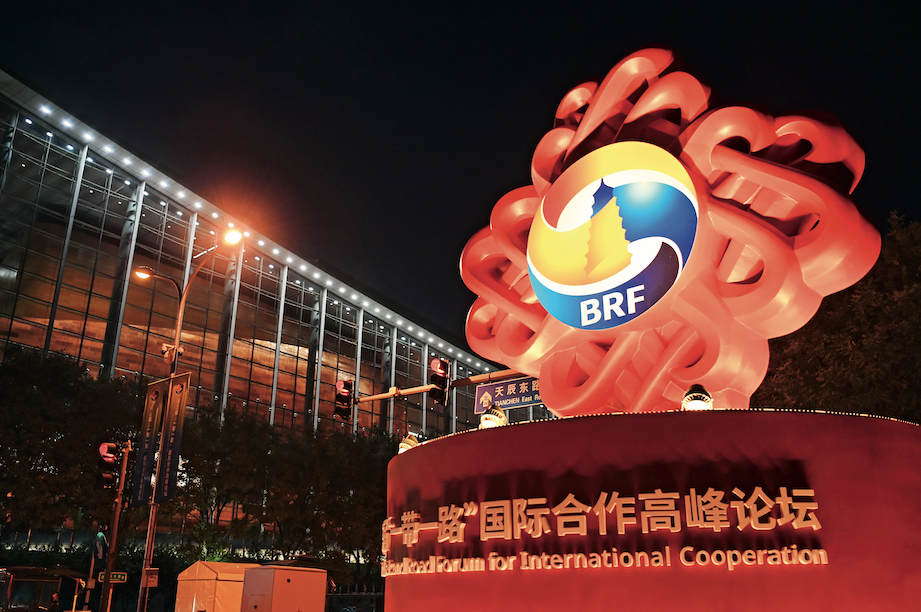
⬆ 2023年10月18日,第三届“一带一路”国际合作高峰论坛在北京召开(中新社发 胡庆明摄)
第二个十年重心
习近平主席在峰会上提出了“一带一路”未来发展的八项重大战略,明确表达了在全球范围内不断壮大发展的愿景和决心。这一独特的一体化将传承开放、包容、多元特色,继续致力于实现参与国和机构的互惠互利,让合作共赢在关键时刻惠及世界。正如习近平主席所言,“共商、共建、共享”是“一带一路”的宗旨。这不仅是经济合作的本质,谈及维护世界和平与地区安全,它同样具有现实意义。我们一再认识到:和平、安全与发展密不可分。概括而言,“一带一路”未来十年合作重点将包括:建立中欧高质量多维立体的互联互通网络;支持开放型世界经济;带动绿色发展;鼓励万众创新;深化人文交流;打造合作企业合规评估体系;推动诚信为本的合作;加强制度建设。
高峰论坛的盛况也向外界释放了一个清晰的信号:参会国家都有强烈意愿、兴趣和决心彼此加深理解,团结一致为全人类共同的美好共赢未来协同合作。此外,这次峰会还为多国领导人提供了难能可贵的双边交流机会,就共同关注议题展开磋商,包括如何缓解地区紧张局势、推动停战(如在乌克兰和中东发生的战争),打通资源渠道,激发人力和经济潜能,以更好满足各国平等发展和安全需求。简言之,即如何构建民主、公正、惠及全人类的多极世界秩序。
塞尔维亚、中国与一带一路
独立自主、军事中立的塞尔维亚和中国是传统朋友和真正的伙伴。两国关系积淀深厚,扎根于彼此信任与相互尊重。塞中两国在国际舞台尤其是在联合国平台互相支持,共同维护合法权益。塞方奉行一个中国政策;中方支持塞尔维亚维护主权和领土完整,认同科索沃和梅托希亚省是塞尔维亚领土不可分割的一部分。
自“一带一路”倡议以及中国-中东欧国家合作机制启动以来,塞尔维亚在其实施过程中扮演了重要的角色。作为巴尔干和中欧国家,地处欧亚走廊的十字路口,塞尔维亚积极促进互联互通和推动贸易,现已成为中国-欧洲(欧盟)“一带一路”框架下合作的枢纽和桥梁。尤其是以地中海港口(比雷埃夫斯港、塞萨洛尼基港)为起点,直抵中欧和北欧的陆海快线,这一贸易新通道的开辟少不了塞尔维亚的助力。
2016年的转折点
塞中合作历史悠久,进展顺利。习近平主席在2016年对塞尔维亚进行国事访问期间,宣布中塞建立全面战略伙伴关系,为两国友好关系开启了新篇章。双方签定的多项协议,为贸易、基础设施投资、能源生产、工业、公共服务等多领域深入合作提供了法律依据。
与此同时,双边贸易额增长达185倍。中国企业(中国铁建、中国山东国际、中国交通建设集团、中国中铁、山东高速集团、玲珑兹雷尼亚宁)为塞尔维亚建造了数百公里的现代化公路、桥梁、工业、矿山、铁路、实验室等。在塞尔维亚经营的三家中国公司(紫金矿业、紫金波尔铜业和位于贝尔格莱德的HBIS集团塞尔维亚钢铁公司)位列塞尔维亚企业出口前三甲。中国现为塞尔维亚第二大贸易伙伴,自2021年,中国也一跃成为了塞尔维亚第一大外资来源国。在塞内运营的中国企业雇用了超过20000名员工。通过“一带一路”和中国-中东欧国家合作机制建成的现代化公路遍布塞尔维亚境内外,极大提升了塞尔维亚的地缘政治地位,加深了该区域的互联互通,也提振了塞国国民经济生产。
经济合作取得丰硕成果的同时,其他领域的合作也在不断推进。日益增多的科学、教育、文化、体育、青年、智库等多方互动合作赋予了人文交流更多可能性,其中尤以旅游合作前景最为广阔。塞尔维亚在北京开设了文化中心,贝尔格莱德的中国文化中心则是全欧规模最大、最宏伟的文化中心之一。该中心位于孔子广场1号,毗邻中国驻南联盟使馆旧址(截至1999年4月)。这座大楼因北约发动对塞尔维亚非法军事入侵行动遭飞机轰炸而毁(但显然是误炸)。几年前生效的中塞互免签证、互通直航协议掀起了人文交流的新高潮。贝尔格莱德-天津直飞航班现已开通,额外规划的贝尔格莱德与北京、上海的直航航线开通事宜目前也在商谈中。
成功标志
塞尔维亚与中国在“一带一路”框架下成功开展经济合作的标志有很多,但其中有两个最富盛名且别有深意。第一个标志是位于多瑙河畔、雇有5000多名员工的河钢斯梅戴雷沃钢厂。习近平主席2016年到访时曾表示塞尔维亚和中国是”铁杆朋友”,这一称呼由此传开。第二个标志是全长超过350公里连通塞尔维亚和匈牙利两国首都的贝尔格莱德-布达佩斯高速铁路(又名匈塞铁路)。通车后,两地通行时间将从现在的8小时缩短至2.4小时。贝尔格莱德至诺维萨德首段建设现已完工,2022年起已开通运营。塞尔维亚至匈牙利边境段建设预计将于2024年底完成改造,而包括匈牙利段在内的整个项目预计将于2025年底竣工。这将是中国在欧洲投资承建的第一条高速铁路,也将是欧洲第一条配备无线通信系统的铁路。贝尔格莱德-布达佩斯铁路将地中海比雷埃夫斯港和塞萨洛尼基港与中欧和东欧、北海和波罗的海垂直连接,是欧洲10号走廊铁路现代化改造的重要部分。值得注意的是,根据高级代表的公开声明,欧盟委员会最近向塞尔维亚提供了财政援助,用于同一条欧洲10号走廊贝尔格莱德到尼什段铁路(长240 公里)南线的现代化升级改造。
10月17~18日,塞尔维亚总统亚历山大·武契奇率团访问了中国,偕同随行的几位政府部长和企业家代表出席了本届高峰论坛和企业家大会。塞尔维亚和中国签署了18项新协议,包括具有战略高度和长远意义的自由贸易协定。中塞自贸协议将为双边贸易发展注入新动能,尤其将带动塞尔维亚食品、葡萄酒和烈酒、肉类以及工业产品的出口。武契奇总统和习近平主席就如何扩大双边、多边合作,尤其是“一带一路”和中国-中东欧国家合作机制框架下的深化合作,举行了深入会谈。两位领导人重申了两国国家和人民之间的“铁杆友谊”,并表达了相互开放,加强所有领域互利合作的意愿。两国领导人也分别强调了坚持一个中国原则和尊重塞尔维亚主权和领土完整的重要性。会议期间也再次确定了贝尔格莱德-布达佩斯高速铁路将于2025年底前竣工。塞尔维亚和中国的友好关系和全面合作堪称中国同欧洲国家友好关系的典范。
在武契奇总统十月访华参加高峰论坛并与习近平主席会谈后,塞尔维亚与中国的合作和政治对话又有了新的动力。塞尔维亚总理安娜·布尔纳比奇于11月4~6日访问上海,代表塞尔维亚作为主宾国出席了上海国际进口博览会。她先是与李强总理举行了会谈,后于11月6日在北京受到了习近平主席的接见。此行塞尔维亚总理会见了包括上海可再生能源有限公司在内的重要商业伙伴。
定期的高级别政治对话与务实的商务谈判,促成了不同凡响的塞中关系与合作。
塞中合作及全面战略伙伴关系,积极参与“一带一路”和中国-中东欧国家合作机制框架下的国际合作,让塞尔维亚收获了多方面利益。
首先,塞尔维亚在国家经济重建和社会经济发展方面获得了极其重要的稳定支持;在核心基础设施的更新、现代化和扩建方面获得了资金支持,特别是跨境通讯网络建设。至关重要的一点是中国从未设置任何政治前提条件,在所有领域都是无条件支持塞尔维亚。
第二,塞尔维亚引进了新技术,改善了本国就业状况,尤其是受过教育的年轻人获得了更多就业机会。人民生活水平得到了提高。
第三,“一带一路”和中东欧合作有助于塞尔维亚连通欧洲和全球基础设施与贸易;实现公路、铁路、电信、电力生产的现代化;与诸如5G、人工智能、机器人、绿色发展等新技术和创新源头紧密相联。
第四,保持国内生产总值的高增长率,从而缩小本国经济与欧洲(欧盟)发达经济体的发展差距。多年来,塞中合作以及“一带一路”、中国-中东欧国家合作机制框架下的合作不负众望,充分证明了这一展望的合理性。即使是在欧洲经济衰退的今天,塞尔维亚也成功地保持了比大多邻国(其中一些是欧盟成员国)都要高的国内生产总值增长率。
第五,保持并进一步推进与邻国、西半球国家,特别是欧盟成员国合作的同时,塞尔维亚也在努力扩大加强与中国、俄罗斯、印度以及全球南方国家的合作,从而确保地缘政治格局中经济利益的均衡分布。
塞尔维亚从自身经验中清楚地认识到经济和财政过度依赖地缘政治一方的风险。经济主权并不像某些人假装的那样是过时的价值观。可能只是维护经济主权的条件和方式发生了变化。
塞尔维亚坚信,维护独立自主、捍卫主权与领土完整、开放互利合作、保持军事中立以及尊重《联合国宪章》原则是通往美好生活的捷径。塞尔维亚毋须被训教谁为“民主国家”,谁为“专制国家”,谁传播“恶劣影响”,谁煽动“颜色革命”,谁是“可靠或不可靠”伙伴。选择合作伙伴和合作领域的自由是不可剥夺的主权权利。
By [Serbia] Zivadin Jovanovic,
President of the Belgrade Forum for a World of Equals and Silk Road Connectivity Research Center
The Third Belt and Road Economic Forum (BEF), held on 17-18 October 2023 in Beijing, was a global event of historic importance. It was devoted to marking the first decade since the inception of the Global Development Belt and Road Initiative (BRI), launched by the President of the People’s Republic of China, Xi Jinping, in September 2013. Attended by heads of state or government and other high representatives of 140 countries of Asia, Africa, Latin America, and Europe, as well as by representatives of 30 international organizations, including Secretary General of United Nations Antonio Guterres, the BEF has summed up unprecedented achievements in the past 10 years and laid down the firm foundations for continuity and clear vision of future priorities.
The Third BEF Summit was, by all standards, an extraordinarily important global event with messages of economic, political, and cultural nature. Extraordinary attention of the world public comes from its agenda which, essentially, focused on the BRI’s role in building a jointly safe and prosperous shared future for mankind.
The Beijing Third BEF Summit has summed up great achievements in the implementation of the goals set up 10 years ago. 150 countries and 30 international organizations have signed agreements for cooperation under BRI. The total value of investments in the development projects under BRI amounts to about one trillion US dollars. New trans-regional and trans-continental economic corridors have been established, and modern railways, roads, pipelines, electric grids, industrial parks, clean energy blocks, and many other projects have been built, providing new employment and better life for millions of people all over the world.
Modernization and construction of the global infrastructure and establishment of direct continental and intercontinental routes, railways, seaways, and airways have extended and reinforced physical connectivity among countries, continents, and oceans without precedent in history.
People-centered orientation has always been of utmost importance in all fields of cooperation, including “small yet smart” programs, health laboratories, food production, education, and tourism. Cultural, scientific, and people to people exchange has been rising steadily, promoting mutual learning, understanding, and trust amongst peoples and civilizations. No other known initiative or international integration has ever contributed so much to the growth of the global economy and better life of the people on the planet as cooperation under the BRI has done. This has been the BRI’s way of building peace through the development and community of a shared future for mankind.
The holding of the Third BEF Summit and CEO Conference, in parallel, coincided with the deepening of tectonic changes in global relations. Many new cooperation agreements have been signed during CEO conference, amounting to USD 97.2 billion in total. Two major Chinese banks – Development Bank and Export-Import Bank – have each set up a RMB 350 billion financing window. An additional amount of RMB 80 billion will be available to the Silk Road Fund. It was announced that China will carry out 1000 small scale livelihood assistance projects.
The global majority strives towards intensification of the process of building the new multi-polar world order based on equality, openness, inclusiveness, noninterference, and freedom of choice of socio-economic development. New democratic governance of global relations will serve equal rights and needs of all nations, all regions, and all human beings, not the chosen ones only. It has become quite clear that the global majority stands firmly by universal principles and values, by International Law enshrined in the UN Charter, not by so-called “rules” promoted by self-proclaimed “defenders” of democracy, human rights, and so on. The global majority firmly rejects any form of neocolonial relations, hegemony, or interference in internal affairs. They perceive BRI, its principles, institutions, and new integrations like BRIKS+, SCO, and EAEU as the pillars and forerunners of the just and truly democratic world order.
In the time of looming global recession provoked by broken supply lines, protectionism, illegal sanctions, energy and food crises, and enormous spending in wars and armament instead in development, the Third BEF Summit became the largest, unique global forum that successfully prioritizes constructive approaches to sustainable development, stability, responsible governance, mutually beneficial cooperation instead of provoking Cold War divisions, confrontations and, even, wars, thus restraining peaceful development.
China’s people and leadership headed by President Xi Jinping, provided lasting and steady progress in all spheres of internal socio-economic development, as well as in open bilateral and multilateral cooperation, in contributing to resolving the main world challenges and crises. “China can only do well when the world is doing well,” said President Xi Jinping in his opening remarks. China has become a synonym of the policy of openness and reform, rejuvenation and innovation, adaptation and stability, elimination of poverty, and highest achievements in the fields of G5, AI, robotics, microbiology, and space exploration – in new technologies in general. The country’s ability to face new challenges and seek solutions in the interest of all, to keep initiative and prosper, to always perceive its own development closely linked with the global and development of others have won China a reputation of a friendly and trustful partner. A number of global initiatives, such as Development Initiative, Peace Initiative, Civilization Initiative, and normalization of relations between Saudi Arabia and Iran have been acclaimed by the world public and all responsible, peace and prosperity-oriented people.

⬆ ⬆ On October 18, 2023, Chinese President Xi Jinping attended the opening ceremony of the 3rd “Belt and Road” International Cooperation Summit Forum in the Great Hall of the People in Beijing and delivered a keynote speech(Photo by Jiang Qiming, journalist from China News Agency)
Second Decade Priorities
Eight major steps strategy presented by President Xi Jinping at BEF Summit for the future development under BRI confirms a clear vision and determination that this unique integration will continue to gain strength and grow globally, open, inclusive, and multidimensional for the mutual benefit of participating countries and organizations, as well as for the benefit of the global economy at its crucial juncture. In the words of President Xi Jinping, the BRI is: “Planning together, building together, and benefiting together.” Although it is pronounced in the context of economic cooperation, it is equally relevant when talk goes about the need to safeguard peace and equal security for all. Time and again, we realize that peace, security, and development are indivisible. Priorities for the next decade of cooperation under BRI include, among other: building high quality multidimensional connectivity networks in China and Europe; supporting an open world economy; green development; innovation for all; people-to-people exchange; compliance evaluation system for companies involved in BRI cooperation; promoting integrity-based BRI cooperation; strengthening institutional building.
BEF Summit was a clear manifestation of the will, interest, and decisiveness of all to work together, deepening mutual understanding, solidarity, and win-win cooperation – for a better future for humanity. In addition, the Summit provided an excellent opportunity for bilateral exchange among leaders of so many countries about issues of mutual interest, including ways and means to end tensions, confrontation, and wars, such as one in Ukraine and the other in the Middle East, how to channel resources, human and economic potentials to better satisfy the needs for equal development and equal security of all countries. To sum it up – how to build a democratic, just, pro-human multi-polar world order.
Serbia, China, and BRI
Independent, military neutral Serbia and China are traditional friends and true partners. Their relations are based on profound mutual trust and respect. They support each other in safeguarding legitimate rights and interests in international forums, particularly in the United Nations. Serbia supports the policy of One China; China supports Serbia’s sovereignty and territorial integrity, considering that the Province of Kosovo and Metohija remains an integral part of sovereign Serbia.
Since its inception, Serbia has played a prominent role in implementation of the BRI and China-CEEC cooperation under BRI. Being a Balkan and central European country, a crossroad of regional and Euro-Asian corridors, Serbia has arisen as the hub and bridge in China-Europe (EU) cooperation under BRI in promoting connectivity and trade and, particularly in enhancing Land and Sea Express Line from Mediterranean Sea ports (Piraeus, Thessaloniki) towards Central and Northern Europe.

⬆ Hibis Group Serbia lron and Steel
2016 Turning Point
While Serbia-China cooperation enjoyed and reached a long history of progress, the state visit of President Xi Jinping to Serbia in 2016 was a turning point in building a comprehensive strategic partnership. Dozens of different agreements have been signed, providing the legal basis for trade cooperation, infrastructure investments, energy production, industry, and public services.
In the meantime, the trade volume has increased 185 times. Chinese companies -China Road And Bridge Corporation (CRBC), China Shandong Int., China Communication Construction Company (CCCC), China Railway Int., Shandong High Speed, LingLong Zrenjanin- have constructed hundreds of kilometers of modern highways, bridges, industries, mines, railways, laboratories. Three Chinese companies operating in Serbia (Zijin Mining, Zijin Copper, Bor, and Hibis Group Serbia Iron and Steel, Belgrade) became the first, second, and third largest exporters from Serbia. China became Serbia’s No.2 trading partner. Beginning in 2021, China became the largest foreign investor in Serbia. Over 20,000 people have been employed in Chinese companies operating in Serbia. National and trans-border modern roads and railways constructed by Chinese companies under the BRI and China-CEEC framework have substantially expanded the benefits of Serbia’s favorable geo-political position, regional connectivity, and productivity of the national economy.
Coupled with impressive economic cooperation, other fields of cooperation have been advancing. People to people exchange is growing in all directions of science, education, culture, sports, youth, think-tanks, especially tourism. Serbia has opened a Cultural Center in Beijing, while China has constructed in Belgrade, one of the largest and nicest cultural Centers in Europe. The Center is located at Confucius Square No. 1, near the place where the building of the Chinese Embassy used to be located by April 1999, apparently by mistake, bombed and destroyed by NATO planes during illegal military aggression against Serbia (FRY). The people-to-people exchange received strong impetus when agreements on abolishing visas and establishing direct air links came into force several years ago. Now, direct flights from Belgrade to Tianjin are operating, and negotiations are underway to establish additional flights from Belgrade to Beijing and/or Shanghai.
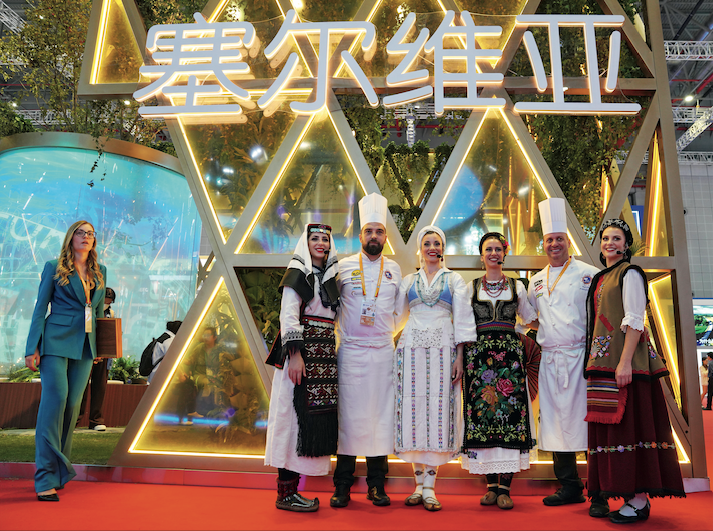
⬆ ⬆ On November 5, 2023, the 6th China International Import Expo opened in Shanghai, and Serbian staff took a group photo to commemorate it
Symbols of Success
There are many symbols of the successful Serbia-China economic cooperation under the BRI. But two of them have particular reputation and relevance. First is Steel and Iron Co. in Smederevo, a town on the Danube River, employing over 5000 people, which President Xi Jinping visited in 2016 and later said that Serbia and China are “Steel Friends”. Ever since then, this expression has become common. The second symbol is the high speed railway Belgrade-Budapest (350km), which will shorten the time of travel between Serbian and Hungarian capitals from the present 8 hours to 2.40 hours. First section of the railway Belgrade-Novi Sad has been completed and functioning since 2022. Serbia’s part till the border with Hungary is expected to be completed by the end of 2024, while the whole project, including Hungary’s section, is expected to be finalized by the end of 2025. This will be the first high speed railway financed and constructed by China in Europe and the first railway with a wireless communication system. Belgrade-Budapest railway is part of the railway modernization on the European Corridor 10, vertically connecting the Mediterranean ports of Piraeus and Thessaloniki with Central and Eastern Europe and the Northern and Baltic Seas. It is noteworthy that, according to public statements of high-level representatives, the European Commission has recently offered Serbia financial assistance for the modernization of the southern railway branch on the same E-10 Corridor from Belgrade to Nis (240km).
Serbian delegation headed by President Aleksandar Vucic and comprising several government ministers and a number of CEOs participated at the BEF Summit and CEO Conference. A new set of 18 agreements had been signed between Serbia and China, including a strategically important Agreement on free trade. It is expected that this Agreement will inject new impetus into bilateral trade, boosting, especially, Serbian export of food, wines and spirits, meat, as well as industry products. President Aleksandar Vucic and President Xi Jinping held strategically important talks about the ways to expand and intensify bilateral, multilateral, and especially cooperation under the BRI and CEEC framework. The two presidents have reaffirmed “steel friendship” among two countries and peoples, mutual openness, and readiness to expand and intensify all fields of mutually beneficial cooperation. They underlined the importance of adherence to the policy of one China and respect of sovereignty and territorial integrity to Serbia, respectively. The end of 2025 was reaffirmed as the deadline for completing the high-speed railway Belgrade-Budapest. Serbia-China friendly relations and comprehensive cooperation have been praised as a good example and inspiration.
After the October 17-18 visit of President Aleksandar Vucic to China, his participation at the BEF Sumit, and talks with President Xi Jinping, the dynamics of Serbia-China cooperation and the political dialogue have received new impetus. Serbia’s Prime Minister Ana Brnabic visited Shanghai on 4-6 November to represent Serbia as the guest of honor at the Shanghai International Import Expo (CIIE). She held talks with Prime Minister Li Qiang and, on November 6th, was received by President Xi Jinping in Beijing. Serbia’s Prime Minister met a number of important business partners, including from Shanghai Renewables Co., with whom she discussed implementation of renewable energy project.
Regular highest-level political dialogue, paired with practical business negotiation, continues to distinct Serbia-China relations and cooperation.
Serbia’s cooperation and strategic comprehensive partnership with China, as its active role in international cooperation under the BRI and China-CEEC framework, has brought Serbia multifaceted benefits.
First of all, Serbia received significant and stable support for the economic reconstruction of the country and dynamic socio-economic development; finances to renew, modernize, and extend essential infrastructure, particularly trans-border communication connectivity. It is crucial that China has never put any political precondition to support Serbia in any field.
Second, Serbia brought in new technologies and improved employment, especially for young, educated people. Living standard improved.
Third, BRI and CEEC cooperation helped Serbia to get better connected to the European and global infrastructure and trade; to modernize roads, railways, telecommunications, and electricity production; to be closely connected to the sources of innovation and new technologies, such as 5G, AI, robotics, green development and so on.
Fourth, to secure a higher rate of GDP rise, thus helping the national economy to bridge the development gap towards developed economies of Europe (EU). Over the past years, Serbia’s cooperation with China, BRI and CEEC frameworks has justified this expectation. Even today, in the period of recession in Europe, Serbia succeeds in maintaining a higher GDP rise than most of her neighbors, some of whom are EU members.
Fifth, maintaining and further developing cooperation with neighboring countries, countries of the western hemisphere, particularly with EU member countries, Serbia, at the same time, is working hard to expand and intensify cooperation with China, Russia, India, and countries of the Global South, thus endeavoring to secure more balanced dispersion of economic interests on geopolitical landscape.
Drawing from its own experience, Serbia understands well the risks of being economically and financially over-dependant on one geopolitical side. Economic sovereignty is not an outdated value, as some pretend. It may be that only conditions and ways to safeguard it have changed.
Serbia is confident that her best way to a better life is by safeguarding independence, sovereignty, territorial integrity, openness for mutually beneficial cooperation, military neutrality, and respect for the principles of the UN Charter. Serbia does not need to be taught who are “democracies”, who are “autocracies”, who spread “malign influences”, and who export “colored revolutions”, who are “reliable” and who are “unreliable” partners. Freedom to choose partners and areas of cooperation is an unalienable sovereign right.


